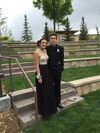BME100 f2016:Group16 W8AM L6
| Home People Lab Write-Up 1 | Lab Write-Up 2 | Lab Write-Up 3 Lab Write-Up 4 | Lab Write-Up 5 | Lab Write-Up 6 Course Logistics For Instructors Photos Wiki Editing Help | ||||||
|
OUR COMPANY
Our Brand Name LAB 6 WRITE-UPBayesian StatisticsOverview of the Original Diagnosis System For this PCR lab, 32 patients were tested for the disease-associated SNP by have 16 teams of 4-5 students test two patients each. To prevent error, each team was to create triplicates of each patient sample and PCR control. Then for the analysis with ImageJ three pictures were taken for each drop and each calibration control. This provided us with a enough data to ensure that we could conduct a reliable analysis and receive reliable results. The biggest challenge in collecting data was taking the photos of the droplets in the fluorimeter. The camera we utilized was light sensitive and would refocus after the lid was closed. This resulted in blurry photos. Also for a few photos the lid could not be completely closed because in order to take the photo someones had had to be in the box to take the photo. This meant that not all the light was completely blocked making it harder to detect the blue light and the green glow of the dot. Even though, we were able to diagnosis that patients successfully. Majority of the patient data was used for the bayesian statistics. Four patients had no data because the analysis of their results was not completed and not ready for statistics to be conducted. Therefore only 28 patients analyzed with Bayesian stats. Four of the patients analyzed had inconclusive results. 7 of the 28 patients diagnosis did not match the doctor's diagnosis. 21 of the patients were successfully diagnosed. What Bayes Statistics Imply about This Diagnostic Approach
The conclusions themselves however, are not very reliable. Using Bayesian statistics again, there is only a little more than 50% chance in a patient developing the disease given a positive final test conclusion. There is a slightly higher probability in a patient not developing the disease after receiving a negative final conclusion. One error could be a result of possible errors in concentrations of solutions needed to run the PCR. Another error could result from errors in collecting images of using a smartphone. The newer models of popular smartphone auto-focus all images, which results in a decreased sensitivity of the detection. A third error could result from surrounding light getting in the fluorimeter, affecting the sensitivity of the sensitivity of the flourimeter as well. Intro to Computer-Aided Design3D Modeling Our Design
Feature 1: ConsumablesWhat will be included in the package: 1) PCR solution 2) Patient samples 3) PCR test tubes 4) Micropipettte 5) Micropipette tips The consumables package will include the PCR solution, the patient samples, PCR test tubes, micropipettes, and micropipette tips. These will be clearly labeled. The PCR solution and the patient samples are important because they are need to conduct the OpenPCR. PCR test tubes because the samples and PCR solution will be placed in these tubes and then put in the OpenPCR. Additionally, the micropipette and micropipette tips will be used to to put the solution in the tubes.
Feature 2: Hardware - PCR Machine & FluorimeterIn our new design we will still incorporate the Open PCR machine and the fluorimeter. The Open PCR machine isn't getting changed but when it comes to the fluorimeter, we've decided to add an adjustable holding slot to support the camera in the right position while it takes the pictures. Along with that we decided to include a magnetic door that will close to keep out light and get the most accurate pictures possible. We'll also have a hole in the door that meets up with the screen of the phone, and allows access to the screen to be able to still use it while keeping the door shut and keeping all light out.
| ||||||





